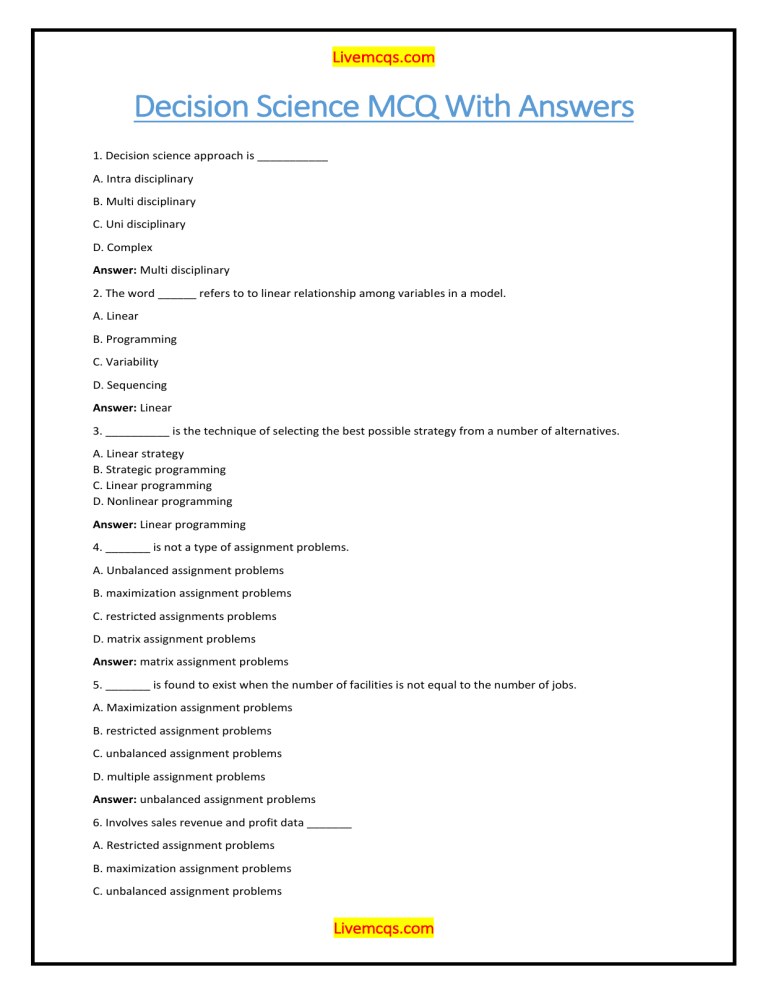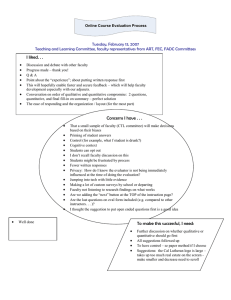
Livemcqs.com Decision Science MCQ With Answers 1. Decision science approach is ___________ A. Intra disciplinary B. Multi disciplinary C. Uni disciplinary D. Complex Answer: Multi disciplinary 2. The word ______ refers to to linear relationship among variables in a model. A. Linear B. Programming C. Variability D. Sequencing Answer: Linear 3. __________ is the technique of selecting the best possible strategy from a number of alternatives. A. Linear strategy B. Strategic programming C. Linear programming D. Nonlinear programming Answer: Linear programming 4. _______ is not a type of assignment problems. A. Unbalanced assignment problems B. maximization assignment problems C. restricted assignments problems D. matrix assignment problems Answer: matrix assignment problems 5. _______ is found to exist when the number of facilities is not equal to the number of jobs. A. Maximization assignment problems B. restricted assignment problems C. unbalanced assignment problems D. multiple assignment problems Answer: unbalanced assignment problems 6. Involves sales revenue and profit data _______ A. Restricted assignment problems B. maximization assignment problems C. unbalanced assignment problems Livemcqs.com Livemcqs.com D. multiple assignment problems Answer: maximization assignment problems 7. Restricted assignment problems is also known as _______ A. Limited assignment problems B infinite assignment problems C. constrained assignment problems D. stagnated assignment problems Answer: constrained assignment problems 8. Decision science is a _______ for solving management problems in order to help managers to make better decisions. A. Pseudo scientific approach B. Artistic approach C. Scientific approach D. Astrological approach Answer: Scientific approach 9. Decision science encompasses a number of mathematically oriented technique such as _____ A. Natural sciences B. Mathematics and statistics C. Engineering D. All of the above Answer: All of the above 10. _______ are those statistical and operations research for programming techniques which help in the decision making process A. Qualitative techniques B. Quantitative techniques C. Assumptive techniques D. None of the ab Answer: Quantitative techniques 11. _____ is the characteristic of quantitative technique. A. Objective oriented approach B. Interdisciplinary approach C. Scientific approach D. All of the above Answer: All of the above 12. _________ are used to allocate resources to activities in such a way that some measure of effectiveness is optimized. A. Queuing models Livemcqs.com Livemcqs.com B. Sequencing models C. allocation models D. simulation models Answer: allocation models 13. ________ deals with the problem of of determination of how much to order at a point in time and went to place an order A. Waiting line model B. Sequencing model C. replacement model D. inventory model Answer: inventory model 14. ________ are used when one must decide the optimal time to replace equipment for one reason or the other A. Replacement models B. allocation models C. decision making models D. waiting line models Answer: Replacement models 15. _______ deals with the selection of an optimal course of action given the possible pay offs and their associated probability of occurrence A. Simulation model B. competitive model C. network model D. decision making model Answer: decision making model 16. For analyzing a problem decision-makers should generally study _______ aspects A. Quantitative B. Qualitative C. Paranormal D. Both A & B Answer: Both A & B 17. Decision variables are _______ A. Independent B. Uncontrollable C. Controllable D. Qualitative Answer: Controllable ( See Explanation) Livemcqs.com Livemcqs.com 18. Decision science is also called ______ A. management science B. operation research C. Quantitative analysis D. All of the above Answer: All of the above 19. Decision science is an approach to decision making which utilizes extensively____ A. Qualitative analysis B. Digital analysis C. Quantitative analysis D. Informative analysis Answer: Quantitative analysis 20. ______ is not an advantage of quantitative technique. A. Facilitates optimum allocation of resources B. Facilitates forecasting C. Serve as a technique to optimise complexity D. Serve as a tool for scientific analysis Answer: Serve as a technique to optimise complexity 21. _________ is used to characterize the behaviour of two or more opponent’s who compete for the achievement of conflicting goals A. allocation model B. decision making model C. game theory model D. Simulation model Answer: game theory model Livemcqs.com


